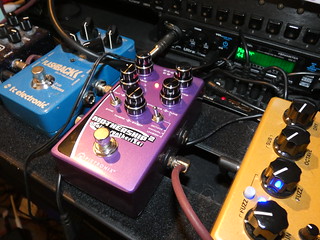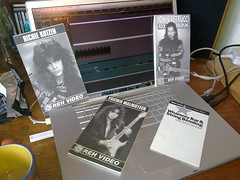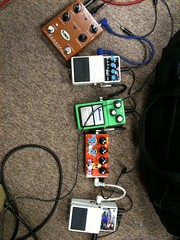Here’s a thing I haven’t posted in a while – a new video up on YouTube, called the Strangest Of Things (for reasons that may become apparent when you hear it.)
 The other day, I got a new pedal – it’s one I’ve been wanting to try for a LOOOONG time, so I was excited to sit down and get some experimenting time in with the Pigtronix Mothership 2 Analog Synth. Those of you who’ve been following things here fro a while will know that I view pedals and processing as part of my instrument – change a pedal and it fundamentally changes what my instrument is. I don’t view it as processing a bass guitar, but building an instrument that makes a range of sounds in a number of ways. So sticking something as radically sound-altering as a synth pedal in there has all manner of amazing possibilities.
The other day, I got a new pedal – it’s one I’ve been wanting to try for a LOOOONG time, so I was excited to sit down and get some experimenting time in with the Pigtronix Mothership 2 Analog Synth. Those of you who’ve been following things here fro a while will know that I view pedals and processing as part of my instrument – change a pedal and it fundamentally changes what my instrument is. I don’t view it as processing a bass guitar, but building an instrument that makes a range of sounds in a number of ways. So sticking something as radically sound-altering as a synth pedal in there has all manner of amazing possibilities.
As you can maybe see from the pic, there’s a TON of control over the sound – meaning you can either get a very specific sound you want and leave it (the other video I posted yesterday to Instagram was more of that kind of approach, trying to get Bernie Worrell’s keyboard bass sound from Flashlight…) or you can have it at hand-height and tweak it the way you would a modular synth.
So, here’s the video:
I’m running my Elrick Gold Series SLC signature fretless 6 into a signal path that includes the Aguilar Tone Hammer, Pigtronix Philosopher compressor, Jule Monique tube preamp, MOD Duo running a wide stereo chorus, EQ and a cab sim, and then the MXR Reverb for those trapped chords in the middle. The fretless seems like the perfect instrument for experimenting with synth, as it gives you a second way to control the portamento on the notes – the Mothership 2 has a ‘glide control’ – you can hear that towards the end, where the notes start swooping up and down in insane ways – but I can control that glide as well on the fretless just by sliding 🙂
The cut-up effect at the beginning is all done in the Looperlative LP1 – the effect is ‘quantise replace’, and I’m swapping out 1/16th of the loop each time, sometimes with a block that’s an octave higher (by changing the speed of the replaced bit) and sometimes it’s pitch-shifted (but slowing down the loop by a particular fraction while the replace is happening) – it starts chaotic, and suddenly this amazing glitchy beautiful ostinato emerges! The filter at the end is the Kaoss Pad Mini – the drums and the glitch-line are on different tracks in the LP1, so I can route that synth part to the aux out which has the KP Mini after it.
The glitchy drum sounds are a sample set I assembled from various sources in FL Studio played in on the Quneo. The whole thing is improvised live and unedited.
I love this stage of getting ideas together with new parts to my instrument – it’s slightly Jackson Pollock-esque in that you get to throw ideas at the canvas and see what happens. How well defined the canvas is depends on how cavalier you are with the rest of the parameters. Here, I’m pretty familiar with that quantise replace function on the Looperlative, though as this is a completely redesigned version of the software (running on the first of the new hardware boxes! yay!) it does actually respond slightly differently… But it’s in 4/4, and it wasn’t to hard to work out what the key centre was once the glitchy line was running (though I can’t fully predict what the notes will be with the pitch shifted replace function! I mean, I could work it out, but I like the madness of it 😉 )Â – so this is experimental stage 0.1 – definitely in Beta mode. Some of the synth stuff has wonky squirrelly pitch, though that does feel more like a 70s thing, given how unpredictable the original voltage controlled synths were…
More soon!!





 Here are the latest couple of videos I’ve put up. The first is another of the experimental ideas I’m working on for the new album – this time I wanted to try something a little more solidly rhythmic, just to see how the replace functions interact with a percussive track. (the part is played by muting all the strings, and then using a ‘double thumb’ technique, more readily associated with slap bass, to get the percussive pattern).
Here are the latest couple of videos I’ve put up. The first is another of the experimental ideas I’m working on for the new album – this time I wanted to try something a little more solidly rhythmic, just to see how the replace functions interact with a percussive track. (the part is played by muting all the strings, and then using a ‘double thumb’ technique, more readily associated with slap bass, to get the percussive pattern). Here’s the two latest bits of ‘public beta test music’ that I’ve put up online.
Here’s the two latest bits of ‘public beta test music’ that I’ve put up online.